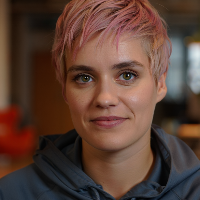Startup. Product and Market
Startup. Product and Market is a practical, no-nonsense course for first-time founders who want to build something people actually adopt—and learn to talk about it credibly with customers and investors. You do not need prior experience in unit economics or …
Overview
Startup. Product and Market is a practical, no-nonsense course for first-time founders who want to build something people actually adopt—and learn to talk about it credibly with customers and investors. You do not need prior experience in unit economics or analytics; we start from first principles and layer in just enough structure to help you make better decisions, faster. The goal is not to turn you into a consultant who can recite frameworks, but into a founder who can identify real problems, size real markets, and craft a go-to-market strategy that earns your first users and keeps them coming back.
Across nine modules, you will learn how to distinguish a truly startup-grade product from a generic business offering; why market understanding is as critical as product craft; and how to avoid classic failure patterns rooted in ignoring demand. You will practice customer discovery the right way—asking non-leading questions, listening for behavior (not opinions), and converting raw interviews into crisp insights. You will learn to compute TAM, SAM, and SOM in plain language, compare top-down and bottom-up methods, and present market size credibly without hype.
We then move into building traction: how to get your first 100 users, assess and scale acquisition channels, and adapt GTM for B2B versus B2C. We cover international expansion basics—timing, localization, cultural fit—and analyze case studies to understand why some strategies worked while others stalled. You will learn what Product-Market Fit (PMF) really looks like, how to measure it with qualitative signals (e.g., user interviews, repeat usage, and NPS) and quantitative metrics (retention curves, churn, growth rates), and how to pivot decisively when PMF is not there.
You will also design an early adopter strategy—who they are, where to find them, how to convert them into advocates, and how to retain them without overbuilding. Special modules address impact/social startups, deeptech with long R&D cycles, and scientific products that must communicate value before traction exists. We will discuss regional barriers (regulation, culture, infrastructure) and how to navigate them early rather than treating them as afterthoughts.
Finally, you will learn to defend your product and market strategy to investors. We unpack typical investor questions, teach you to defend TAM/SAM/SOM under scrutiny, and show how to present small but credible traction by highlighting activation, retention, CAC payback, and pipeline quality. You will practice presenting a roadmap and GTM with clear milestones, realistic assumptions, and transparent data that build trust.
By the end of this course, you will be able to:
- Differentiate startup-grade products from generic offerings and articulate a sharp problem statement.
- Run unbiased customer discovery interviews, synthesize insights, and avoid solution bias.
- Estimate TAM/SAM/SOM using top-down and bottom-up methods and defend your assumptions.
- Design and test a go-to-market plan for your first 100 users and beyond, choosing scalable channels.
- Measure PMF with the right qualitative and quantitative signals, and plan pivots when needed.
- Identify, attract, and retain early adopters—and convert them into credible advocates.
- Adapt approaches to special cases (impact, deeptech, scientific) and regional constraints.
- Communicate with investors clearly, answer hard questions, and present traction with integrity.
Who is this for? Founders at the idea, prototype, or early launch stage who want a clear, rigorous approach to product and market without academic fluff. If you have limited budget and need to learn fast, this course shows you practical methods and affordable tools to validate a market, focus your product, and earn your first wins.
What you need: curiosity, willingness to talk to customers, and readiness to iterate based on evidence. We will provide templates for interviews, market sizing, GTM planning, and PMF tracking so you can apply each module immediately.
Outcome: a focused problem statement, a defensible market size, a realistic GTM plan, early adopter targets, a PMF measurement dashboard, and an investor-ready narrative that avoids hype and survives scrutiny.
Curriculum
- 10 Sections
- 40 Lessons
- Lifetime
- 1. Foundations of Product and Market4
- 2. Customer Discovery Deep Dive5
- 2.1HIKG 2.1 How to conduct customer interviews properly (avoiding biased questions)
- 2.2HIKG 2.2 Learning to listen: extracting insights without pushing your idea
- 2.3HIKG 2.3 Mistakes: falling in love with the product instead of the problem
- 2.4HIKG 2.4 Case studies: customer discovery done right vs. wrong
- 2.5HIKG 2. Quiz3 Questions
- 3. Defining Your TAM/SAM/SOM5
- 4. Go-to-Market Playbook6
- 4.1HIKG 4.1 The first 100 users — tactics for initial traction
- 4.2HIKG 4.2 Finding scalable acquisition channels (paid, organic, partnerships)
- 4.3HIKG 4.3 B2B vs. B2C go-to-market strategies
- 4.4HIKG 4.4 International expansion: timing, localization, and cultural fit
- 4.5HIKG 4.5 Case studies: GTM strategies that worked (and those that failed)
- 4.6HIKG 4. Quiz3 Questions
- 5. Product-Market Fit Metrics6
- 5.1HIKG 5.1 Defining PMF and why it matters
- 5.2HIKG 5.2 Qualitative signals (user feedback, repeat usage, NPS)
- 5.3HIKG 5.3 Quantitative metrics (retention curves, churn, growth rates)
- 5.4HIKG 5.4 PMF across industries: SaaS, e-commerce, marketplaces, mobile apps
- 5.5HIKG 5.5 How to pivot when PMF is not there
- 5.6HIKG 5. Quiz3 Questions
- 6. Early Adopter Strategy6
- 6.1HIKG 6.1 Who early adopters are and why they’re different from mass users
- 6.2HIKG 6.2 Tactics to attract first users (communities, outreach, incentives)
- 6.3HIKG 6.3 Turning early adopters into brand advocates
- 6.4HIKG 6.4 Retention strategies to keep early adopters engaged
- 6.5HIKG 6.5 Case studies: how successful startups built strong early adopter bases
- 6.6HIKG 6. Quiz3 Questions
- 7. Special Cases in Product and Market6
- 7.1HIKG 7.1 Impact and social startups — measuring success beyond revenue
- 7.2HIKG 7.2 Deeptech and complex products — when development takes years before market entry
- 7.3HIKG 7.3 Scientific and R&D-heavy products — how to communicate value without traction
- 7.4HIKG 7.4 Niche products vs. mass-market — how strategy changes
- 7.5HIKG 7.5 Regional barriers — regulatory hurdles, culture, infrastructure differences
- 7.6HIKG 7. Quiz3 Questions
- 8. Defending Product and Market Strategy to Investors6
- 8.1HIKG 8.1 Typical investor questions about product and market
- 8.2HIKG 8.2 How to defend TAM/SAM/SOM calculations under scrutiny
- 8.3HIKG 8.3 Showing traction when metrics are still small
- 8.4HIKG 8.4 Presenting roadmaps and GTM strategies with credibility
- 8.5HIKG 8.5 Building trust with transparent data and realistic assumptions
- 8.6HIKG 8. Quiz3 Questions
- 9. Founder’s Playbook: Practical Advice5
- HIKG FinalQuiz1








